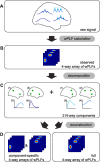Phase-amplitude coupling in human electrocorticography is spatially distributed and phase diverse
- PMID: 22219274
- PMCID: PMC6621324
- DOI: 10.1523/JNEUROSCI.4816-11.2012
Phase-amplitude coupling in human electrocorticography is spatially distributed and phase diverse
Abstract
Spatially distributed phase-amplitude coupling (PAC) is a possible mechanism for selectively routing information through neuronal networks. If so, two key properties determine its selectivity and flexibility, phase diversity over space, and frequency diversity. To investigate these issues, we analyzed 42 human electrocorticographic recordings from 27 patients performing a working memory task. We demonstrate that (1) spatially distributed PAC occurred at distances >10 cm, (2) involved diverse preferred coupling phases, and (3) involved diverse frequencies. Using a novel technique [N-way decomposition based on the PARAFAC (for Parallel Factor analysis) model], we demonstrate that (4) these diverse phases originated mainly from the phase-providing oscillations. With these properties, PAC can be the backbone of a mechanism that is able to separate spatially distributed networks operating in parallel.
Figures








Similar articles
-
How are evoked responses generated? The need for a unified mathematical framework.Clin Neurophysiol. 2010 Feb;121(2):127-9. doi: 10.1016/j.clinph.2009.10.002. Epub 2009 Nov 10. Clin Neurophysiol. 2010. PMID: 19903590 No abstract available.
-
Testing for nested oscillation.J Neurosci Methods. 2008 Sep 15;174(1):50-61. doi: 10.1016/j.jneumeth.2008.06.035. Epub 2008 Jul 15. J Neurosci Methods. 2008. PMID: 18674562 Free PMC article.
-
When frequencies never synchronize: the golden mean and the resting EEG.Brain Res. 2010 Jun 4;1335:91-102. doi: 10.1016/j.brainres.2010.03.074. Epub 2010 Mar 27. Brain Res. 2010. PMID: 20350536
-
Modeling the Generation of Phase-Amplitude Coupling in Cortical Circuits: From Detailed Networks to Neural Mass Models.Biomed Res Int. 2015;2015:915606. doi: 10.1155/2015/915606. Epub 2015 Oct 11. Biomed Res Int. 2015. PMID: 26539537 Free PMC article. Review.
-
Correlations and brain states: from electrophysiology to functional imaging.Curr Opin Neurobiol. 2009 Aug;19(4):434-8. doi: 10.1016/j.conb.2009.06.007. Epub 2009 Jul 15. Curr Opin Neurobiol. 2009. PMID: 19608406 Free PMC article. Review.
Cited by
-
Shaping Information Processing: The Role of Oscillatory Dynamics in a Working Memory Task.eNeuro. 2022 Sep 15;9(5):ENEURO.0489-21.2022. doi: 10.1523/ENEURO.0489-21.2022. Print 2022 Sep-Oct. eNeuro. 2022. PMID: 35977824 Free PMC article.
-
Decreased Phase-Amplitude Coupling Between the mPFC and BLA During Exploratory Behaviour in Chronic Unpredictable Mild Stress-Induced Depression Model of Rats.Front Behav Neurosci. 2021 Dec 16;15:799556. doi: 10.3389/fnbeh.2021.799556. eCollection 2021. Front Behav Neurosci. 2021. PMID: 34975430 Free PMC article.
-
Distinct iEEG activity patterns in temporal-limbic and prefrontal sites induced by emotional intentionality.Cortex. 2014 Nov;60:121-38. doi: 10.1016/j.cortex.2014.07.021. Epub 2014 Aug 14. Cortex. 2014. PMID: 25288171 Free PMC article.
-
Anterior Thalamic High Frequency Band Activity Is Coupled with Theta Oscillations at Rest.Front Hum Neurosci. 2017 Jul 20;11:358. doi: 10.3389/fnhum.2017.00358. eCollection 2017. Front Hum Neurosci. 2017. PMID: 28775684 Free PMC article.
-
Human hippocampal responses to network intracranial stimulation vary with theta phase.Elife. 2022 Dec 1;11:e78395. doi: 10.7554/eLife.78395. Elife. 2022. PMID: 36453717 Free PMC article.
References
-
- Amzica F, Steriade M. The K-complex: its slow (<1-Hz) rhythmicity and relation to delta waves. Neurology. 1997;49:952–959. - PubMed
-
- Beckmann CF, Smith SM. Tensorial extensions of independent component analysis for multisubject FMRI analysis. Neuroimage. 2005;25:294–311. - PubMed
-
- Bro R. Models, algorithms, and applications. Amsterdam: University of Amsterdam; 1998. Multi-way analysis in the food industry.
Publication types
MeSH terms
LinkOut - more resources
Full Text Sources
